There's no denying this year has been one of uncertainty and slowdowns across countless industries. Although opportunities have dried up in some areas, other sectors remain stable and profitable. One such sector is federal contracting. Many enterprises whose commercial markets have suffered this year have leaned more heavily into their contract work for the government.
After taking stock of what the contracting market offers and which businesses are positioned for success, consider the four straightforward steps you'll need to follow to successfully enter this profitable and rewarding market.
The current state of federal contracting
The 2020 Bloomberg Government report revealed that contractor spending is up from last year, with a whopping $597 billion in federal government spending in fiscal 2019, a 6% increase from 2018's $561 billion. This follows four consecutive years of growth since the $442 billion allocated in fiscal 2015, and sets a record high for spending.
Federal contracting provides a viable route for growing your business no matter the size, as the government leans on many different types of service providers beyond leading defense contractors. In fact, the government aims to award at least 23% of federal contracts to small businesses. This includes businesses in:
- Research and development.
- Sustainment supplies and equipment.
- Electronic and communication equipment.
- Clothing and textiles.
- Supplies and equipment.
- Office management.
- Facilities and construction.
- Information technology (IT).
- And many more.
If your business could fill one of these needs, here are the four steps to take to become a federal contractor:
1. Research
The government has strict guidelines, regulations and laws that apply to federal contracts and the businesses that receive them. These vary by industry and sector. Take some time to research and learn about the responsibilities of federal contractors provided by the Small Business Administration (SBA). Any errors or missteps can create costly legal problems.
It's also a good idea to know the six-digit North American Industry Classification System (NAICS) code that applies to your business. This is necessary to compete for federal contracts.
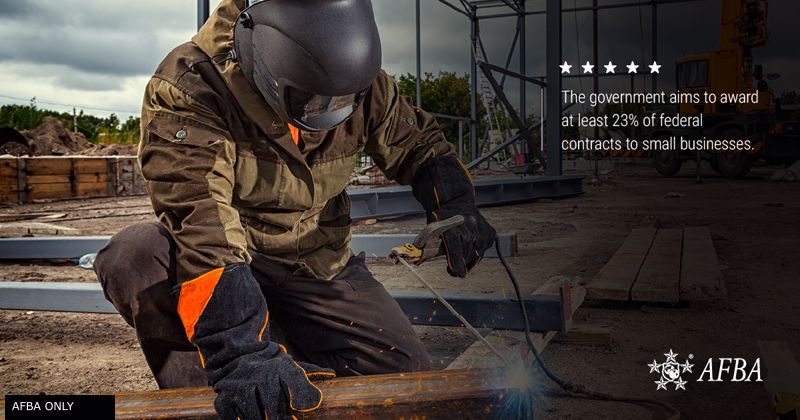
2. Register
Obtaining a federal contract requires registration in a few areas. Much like knowing your industry's NAICS code, you'll also need to register for a Data Universal Numbering System (DUNS) code to apply for federal contracts.
Once you're ready to take the next step, you'll have to register and create an account on the government's System for Award Management (SAM). This is the official site for registering your business with the government. It's also where you'll upload and store important information for your business, such as certifications and licenses.
3. Plan
It's important that you create an internal business plan that directly addresses your external contract proposal. This plan should include your marketing plan for the contract, staffing and employment details, certifications, specialization, experience and other pertinent information that relates to your industry.
You will also need to calculate and include a comprehensive cost analysis and profit-margin outline for the services or products the government will be contracting from your business.
4. Bid
After conducting all the prerequisite research, registration and planning, you can move into the bidding phase. The government's SAM site offers a search option where you can look up procurement notices and bidding opportunities from federal contracting offices. You can search by keyword, soliticiation ID or a particular agency's name.
Once you find a solicitation that fits your business, carefully review all the contracting documentation. If you have any questions, be sure to reach out and ask so that you're fully aware of what the opportunity requires and entails.
Based on this information, follow the solicitation instructions for filling out and submitting all the requested forms, and for providing all the technical, past performance and pricing information in the appropriate manner.
Be prepared to negotiate with the government for the most optimal offer. In many instances, you'll be competing against other industry peers for these contracts, so you'll need to ensure your prices and offerings are the best possible that you can provide.
With this year's tumultuous employment landscape and renewed emphasis on keeping communities strong, many people are looking for ways to step up and help out or are considering a new career. A promising opportunity to accomplish this could be employment as a first responder.
Recent data from the U.S. Bureau of Labor Statistics (BLS) shows that the number of first responder jobs is expected to grow significantly over the next decade. Collectively, analysts are forecasting roughly 77,900 new career opportunities for this sector, which includes firefighters, police officers, emergency medical technicians (EMTs) and paramedics.
Although local municipal budgets fluctuate with the times — which can impact the bottom line for these sectors — a career as a first responder remains a stable and in-demand job option. There will always be a need for those willing to bravely face emergencies and disasters.
Let's break down how the individual sectors are likely to fare by examining the BLS data with a bit more granularity.
Job outlook for EMTs and paramedics
Analysts forecast the number of EMT and paramedic jobs will grow by 17,000 across the U.S. between 2019 and 2029.
With 265,200 jobs as of 2019, this represents a 6% increase over the next decade. Although this might not seem like a big increase, this is faster than the 4% average growth rate across all occupations.
Emergencies like car crashes and natural disasters that require the skills of EMTs and paramedics aren't going to disappear any time soon. Simply put, these jobs are nearly indispensable.

To become an EMT or paramedic requires completion of a post-secondary educational program after high school. While this generally refers to college or university programs, it also covers trade schools and community colleges. Aspiring EMTs and paramedics must then obtain a state license, with the requirements varying from state to state.
Job outlook for firefighters
For firefighters, over the next decade the BLS expects that 20,300 jobs will be added to the current total, which was 335,500 in 2019. Like EMTs and paramedics, this would also account for a jump of 6%, which is faster than the national average.
Those interested in pursuing a career as a firefighter should understand how to go about doing so. While qualifications may vary from one jurisdiction to another, typically individuals need a high school diploma and emergency medical training. Once those requirements are met, the next step is to attend a fire academy to receive proper training and then successfully pass a written and physical test. In many locations, firefighters must also have EMT certification.
Job outlook for police officers
BLS data indicates that police and detective careers are also expected to increase substantially. The next decade should see 40,600 new police and detective jobs to add onto the 813,500 jobs in existence as of 2019. This would represent growth of 5%, which is slightly faster than average.
Continued need for public safety will drive this positive employment change in the coming decade; however, demand will vary by location.
To become a police officer, applicants typically need a high school diploma, although some jurisdictions require a college degree. Applicants must graduate from the local police academy and have on-the-job training before entering the police force.
As we can see, the occupational outlook for first responders remains positive and full of opportunities. Whether you're fresh out of high school or looking for a mid-career change, there will be significant demand for EMTs and paramedics, firefighters and police officers in the coming decade.
Day of the Deployed is a relatively recent military observance, but it is no less meaningful to the men and women who serve on active duty, or the community members that honor their efforts on Oct. 26 each year.
Read on to learn about what the Day of the Deployed observance recognizes, how it came to be and how to support military servicemembers and their families at this time and throughout the year.
Origins of Day of the Deployed
The proposal to create a day recognizing the sacrifices and valor of servicemembers on deployment came from Shelle Michaels Aberle of Solider’s Angels, a nonprofit organization offering support to members of the military community.
In 2006, Aberle pitched the idea to then-governer of North Dakota John Hoeven, after being inspired by her cousin, LTC David Hosna, who was serving in Iraq at the time. North Dakota chose to recognize Day of the Deployed on Oct. 26 — Hosna’s birthday — and many other states quickly followed suit with their own state observances.
Several years later, when Hoeven became a U.S. Senator, he put forth a resolution to enact a nationwide Day of the Deployed. In 2011, this measure passed unanimously in the Senate.
Paying tribute to 200,000 deployed servicemembers
According to the Department of Defense, the U.S. armed forces have a presence across all seven continents, with some 4,800 defense sites across 160 countries. The New York Times estimated that roughly 200,000 servicemembers were deployed overseas as of late 2019.
When the national observance was adopted, Aberle described the state and federal recognition as “an honorable way to extend appreciation to the deployed service members and their families. Day of the Deployed is recognition for their hard work, dedication and commitment to the United States of America. This day is all about them.”
 “The appearance of U.S. Department of Defense (DoD) visual information does not imply or constitute DoD endorsement.”
“The appearance of U.S. Department of Defense (DoD) visual information does not imply or constitute DoD endorsement.”“Our U.S. service men and women currently deployed, along with their loved ones, make untold sacrifices as they serve our nation,” Hoeven remarked on the occasion. “A national Day of the Deployed pays tribute to their commitment to our country and their work to protect our freedoms. We want to ensure that our military members and their loved ones know of our appreciation and support before, during and after their service.”
Ways to raise awareness and offer support
Around the U.S. and across the globe, members and supporters of the military community can find countless morale-boosting ways to mark the occasion. Here are just a few ideas for Day of the Deployed:
- Send handwritten notes or care packages to deployed servicemembers in your life or through a nonprofit organization.
- Make a charitable donation to an organization that supports members of the armed services.
- Bring awareness to the observance and the experiences of deployed members of the armed focus and their families using the hashtag #DayoftheDeployed on social media.
- Display a yellow ribbon in support of the troops serving away from home.
- Spend time socializing with a military family — or offer support in the form of babysitting, running errands or delivering a homemade meal.
You can support a deployed servicemember in your life, or connect with a nonprofit organization to reach out to other military members. And don’t forget that your efforts need not be limited to the official Day of the Deployed.
“Even a small act of gratitude goes a long way,” Nicole Motsek of the EOD Warrior Foundation noted in an interview with U.S. Veterans Magazine. “Any time of the year is a great time to show gratitude for the deployed, but this day serves as a great reminder.”
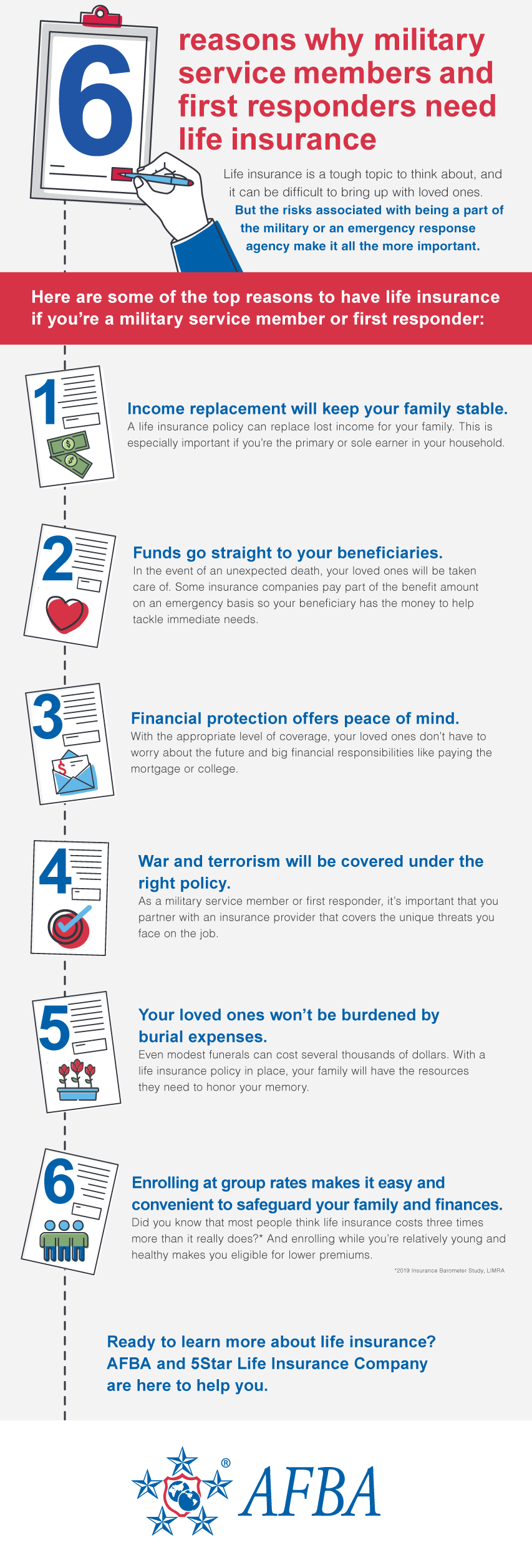
Defense News publishes an annual list of the top 100 defense contractors. But the 2020 Defense News Top 100 does more than just identify leading players in the industry. With some careful analysis, it can offer a snapshot of the current state of defense contracting and hints at what the future might hold. Let’s take a look at which companies top the list, and what trends and takeaways federal contracting companies of all sizes should be aware of.
1. Stagnation among the top 5 spots
A glance at the six leading names in the 2020 Defense News Top 100 would look remarkably similar to past years’ reports. Lockheed Martin has held the No. 1 spot since 2003 — and the company has been the top U.S. contractor by sales for 40 years running.
The same four enterprises have similarly occupied the second to fifth places for several years as well. This year, they rank in order as Boeing, General Dynamics, Northrop Grumman and Raytheon. Typically in 1 of the top 6 spots, BAE systems has fallen to No. 7 this year.
Most major changes in ranking come as a result of mergers, acquisitions and divestitures. For instance, Raytheon Technologies Corporation — a result of the April 2020 merger between Raytheon Company and United Technologies Corporation — was listed for the first time as a signal entity in this year’s list.
 “The appearance of U.S. Department of Defense (DoD) visual information does not imply or constitute DoD endorsement.”
“The appearance of U.S. Department of Defense (DoD) visual information does not imply or constitute DoD endorsement.”2. Growing influence of Chinese enterprises
Eight Chinese companies have taken spots in the 2020 Defense News Top 100 — and the outlet predicts more Chinese contractors will lead the global defense market in the next several years.
“Because these enterprises are state-owned and often part of large, diversified enterprises, the data for annual sales is difficult to obtain,” Defense News author Byron Callan noted in a 2019 assessment, explaining the omission of Chinese companies in the past.
However, the relatively recent inclusion of Chinese companies paints a different picture compared to previous reports. And they aren’t trailing behind U.S. and European entities; they’re clustered at the top of the list. All eight contractors occupy places in the top 24, meaning that China’s state-owned enterprises make up one-third of the top quarter of the list.
Also, it is important to note that the data reflects the activities of an active, international market. Companies are listed by country of origin, but it is not specified what percentage of sales came from their home country, the U.S. or another foreign nation.
3. Stability in spite of the coronavirus pandemic
According to Defense News authors Doug Berenson and Chris Higgins, “Although the defense sector has faced pandemic-related business disruptions, it remains a safe haven, with most defense-oriented firms reporting only modest impact on revenues and profits.”
Most companies that make the list each year follow one of three business models. They either primarily serve the government and defense sectors, serve both defense and commercial clients or operate as industrial conglomerates serving markets far and wide. Enterprises whose commercial markets have been severely impacted by COVID-19 — such as aviation leaders like Boeing — have leaned heavily on the defense market over the past year, according to Berenson and Higgins.
4. Some industry leaders may yet be missing
The ranking methodology is largely dependent on sales data provided by the companies in question. As a result, several influential companies are missing from the 2020 list.
Examples Callan noted in his 2020 Defense News Top 100 analysis include several major players in the U.S. such as SpaceX and BWX Technologies, as well as large defense contractors based in Japan, Spain, Russia, Poland, Australia and India.
Despite the fact that these enterprises remain off the list, at least for the time being, industry analysts still emphasize the importance of keeping an eye on their significant — and, in the case of SpaceX, highly disruptive — contributions to defense contracting.
Since 2017, California has experienced a succession of wildfires that caused historic levels of destruction. At the start of this year, U.S. firefighters were helping battle the Australian bushfires for the first time in a decade. Presently, teams are diligently working to suppress wildfires raging up and down the West Coast, from Washington and Oregon to California.
Given the extreme and unpredictable nature of these incidents, first responders must use a variety of specialized tactics to beat back the blazes. Understanding what happens on the fireground and how skilled firefighters manage and suppress these outbreaks year after year is an important way to recognize their efforts and honor their sacrifices.
Establishing control lines to manage the spread of wildfires
Firefighters strategically create and use boundaries to keep wildfires in containment. These can be natural boundaries, such as rivers, or engineered ones where teams manipulate the landscape to remove any potential fire fuel sources and limit its spread.
Creating a true fire line involves stripping the land down to the soil, but teams often create preliminary scratch lines when they need to work quickly. They'll also establish temporary wet lines by applying water or fire-retarding chemicals to the ground. Explosives are also used to quickly taking down flammable trees and brush.
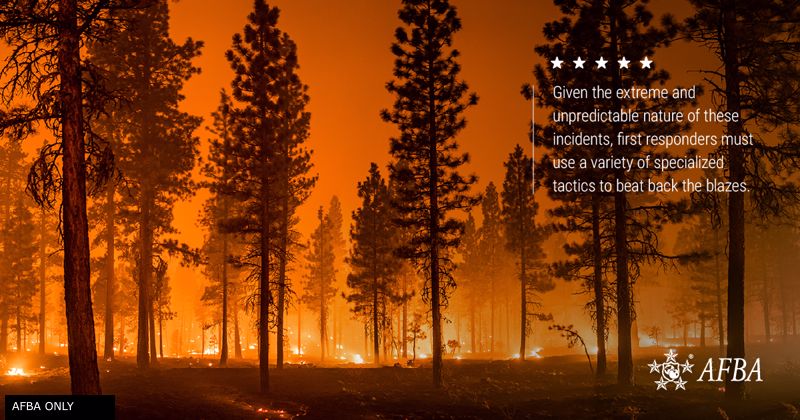
Suppressing flames and embers to keep wildfires in check
When faced with a sizeable wildfire, firefighting teams have to make tactical decisions about how, when and where they will work to extinguish the flames. They will work on the fireground and conduct aerial attacks to keep the fire under control.
Often, the first step will be hotspotting. This involves assessing the overall behavior of the fire and suppressing specific points that pose the highest threat of spreading quickly or causing damage. Teams will also knock down or reduce the heat and flames in particularly active parts of the fire's outer edge using water, soil and fire-retarding chemicals.
Once areas have been contained, firefighters will still work diligently to ensure that the control line remains intact. A mop-up is when embers and burning materials near the control line are removed or extinguished. Cold trailing is a technique where firefighters inspect the "dead" fire edge for any signs of heat. They'll often feel around with their hands to locate and dig out any embers or hot spots.
Using strategic, controlled fires to support containment efforts
It might be surprising to learn that firefighters actually light small fires as a way to manage larger blazes. For instance, teams might conduct a burn out within a new control line to use up the available fuel and bolster the effectiveness of the created boundary. Similarly, firefighters will create backfires downwind of a major fire to change its direction. These advanced techniques require a great deal of experience and careful attention the wildfire's movements.
Initiating prescribed fires to promote healthy ecosystems and reduce risk
Wildfires are a force of nature, and they play a role in keeping ecosystems healthy. A significant amount of scientific research goes into understanding that role and how it can be accomplished in a contained manner that doesn't endanger human lives. The U.S. Forest Services explains that strategic prescribed fires throughout the year help maintain the right balance and reduce the risk of unwanted, uncontrolled outbreaks.
After a major wildfire is successfully extinguished, the work continues with Burned Area Emergency Response efforts. Teams of soil scientists, vegetation specialists, hydrologists, engineers and other experts will evaluate a scorched area. Their assessment will help determine how to stabilize and rehabilitate the environment so it remains safe for the plants, animals and people that inhabit the region.
September is National Suicide Prevention Month — a time for mental health organizations, advocates, suicide survivors and allies in the community to unite, share resources and raise awareness about suicide prevention.
Supported by the Suicide Prevention Lifeline and other groups, the theme for 2020 is #BeThe1To, which outlines simple actions each person can take to help save lives. Keeping with this year’s message, consider these ways to take a small step and make a big difference:
 “The appearance of U.S. Department of Defense (DoD) visual information does not imply or constitute DoD endorsement.”
“The appearance of U.S. Department of Defense (DoD) visual information does not imply or constitute DoD endorsement.”1. Be the one to ask
Studies have shown that talking about suicide with someone who is at risk may actually reduce suicidal thoughts and can even encourage them to seek help.
Directly asking “Are you thinking about suicide?” or “Are you thinking about killing yourself?” in a nonjudgmental way can let someone know you’re there to have an open conversation. Once you’ve initiated a dialogue, be a good listener as the person describes the emotional pain they’re experiencing. Pay close attention to what they say about their reasons for living and help them focus on those factors.
The National Suicide Prevention Lifeline advises against interjecting with your opinions about why you think they should stay alive or promising to keep someone’s suicidal intentions a secret.
2. Be the one to keep them safe
During your conversation, make an effort to learn about the severity of the person’s suicidality. Remaining unbiased and nonjudgmental, gather information about whether they have made any plans or attempts on their life prior to speaking with you. It’s also important to find out whether they have a general idea or specific plan for how the would try to commit suicide, and what this entails with regard to timing and access to their intended method.
With this understanding, you can find ways to put time and distance between the at-risk person and their plan and limit access to lethal methods. Research has shown that suicidal individuals are not likely to choose an alternative method if their original plan becomes unfeasible.
3. Be the one to be there
When people experiencing suicidal thoughts lack a sense of belonging and feel isolated from and even burdensome to those around them, they become even more at risk. Theorists have determined that being there for someone who is considering suicide can offer a critical sense of connectedness which acts as a protective buffer.
Being there for someone can mean spending time with them in person or on the phone and following through when you say you will.
4. Be the one to help them connect
In addition to showing your support, you can also help people in your life build out a safety net by connecting with resources and support services. Organizations offering confidential 24-hour hotlines and online chat services include:
- Veterans Crisis Line: Call 1-800-273-8255 and press 1.
- Suicide Prevention Lifeline: Call 1-800-273-8255.
Suicide is a national public health crisis, especially among the military and veteran communities. But stepping in to help prevent it does not require specialized training. Understanding the warning signs and showing support and compassion saves lives.
The majority of firefighters serving in the U.S. battle the blazes on a volunteer basis, according to the National Fire Protection Association. As of 2018, some 745,000 volunteer firefighters made up 67% of the field.
This line of work poses an unusual level of risk compared to other volunteering opportunities, with an average of 5,330 non-fatal injuries impacting volunteers on the fireground each year. Despite the dangers, what attracts people to these roles? Let’s explore some of the top benefits of being a volunteer firefighter.
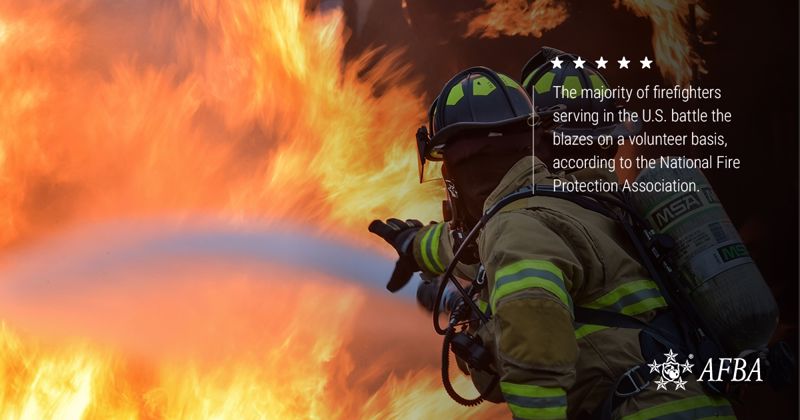 “The appearance of U.S. Department of Defense (DoD) visual information does not imply or constitute DoD endorsement.”
“The appearance of U.S. Department of Defense (DoD) visual information does not imply or constitute DoD endorsement.”Giving back to the community
People who volunteer in any capacity often choose to do so as a way to serve their community and make a meaningful difference.
“The fabric of our nation is strengthened by the service of its volunteers,” CEO of the Corporation for National and Community Service, Barbara Stewart, explained in a press release announcing record-high volunteering numbers. “Each and every day, ordinary Americans are stepping up to support their fellow citizens to help with needs both great and small because they understand the power service has to change communities and lives for the better.”
In that regard, volunteer firefighting offers a unique chance to step in where help is needed most, and impact lives by keep community members, homes and businesses safe.
Feeling a sense of accomplishment
Working as a volunteer firefighter offers a tangible sense of achievement, pride and accomplishment. Not only does this happen through serving others in a volunteer capacity, but volunteers can also take pride in working as part of a team, developing new skills, protecting lives and property and successfully diffusing emergency situations.
Gaining skills and real-world experience
Volunteer roles have a special attraction for aspiring career firefighters. When it comes time to apply for full-time jobs, employers often favor applicants who have hands-on experience working on the fireground. The technical skills and specialized training gained from a volunteer position will certainly help prepare emerging professionals for a career in firefighting.
However, critical soft skills in areas like communication and collaboration can be transferrable skills in any career context. Professional development training programs available through these types of roles can help volunteers bolster their leadership and incident response skills as well.
Connecting with like-minded people
Someone seeking a volunteer firefighter position will be welcomed by a community of passionate, like-minded individuals when they join a local department. This can be an exciting way to make lifelong friends and enjoy camaraderie and fellowship while also growing one’s professional network.
Volunteering on a flexible schedule
Volunteer firefighters aren’t on call around the clock or every day of the year. Instead, they have the opportunity to choose how much time they dedicate to serving with the department. This means they can balance other personal and professional commitments while still having many opportunities to participate in the rewarding work of a firefighter.
Receiving some form of compensation
Just because it’s volunteer work doesn’t mean it’s devoid of any compensation. In fact, the National Volunteer Fire Council notes that fire departments offer tangible benefits to acknowledge the time and money volunteer firefighters spend serving their communities. While each department offers a different set of benefits, possible forms of compensation include:
- Reimbursements for gas or meals.
- Payment for time spent on a call.
- Subsidized insurance.
- Scholarships or tuition assistance.
- Lodging for students.
- Retailer discounts.
- Tax deductions.
- Awards.
- Seasonal bonuses.
- Uniforms and other accessories.
Anyone interested in getting involved and reaping the benefits of being a volunteer firefighter can contact their local fire department to learn more about available opportunities.
Aug. 14 is National Navajo Code Talkers Day. This observance recalls how approximately 400 members of the Cherokee, Choctaw, Comanche, Hopi and Navajo nations partnered with the CIA and the Marine Corps during WWII to develop a complex military code that helped the Allied Forces win.
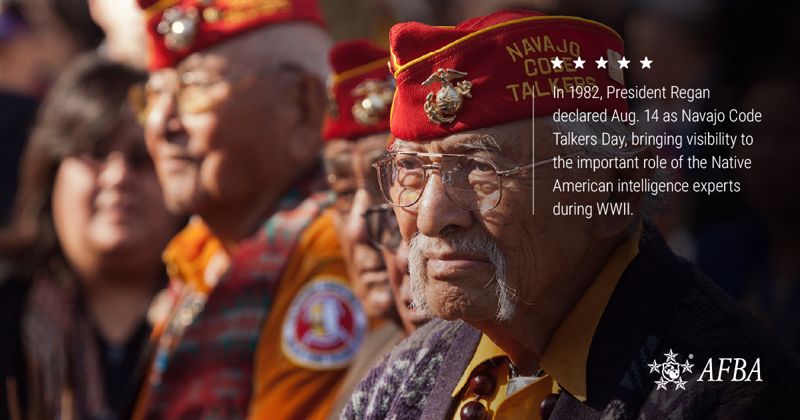 “The appearance of U.S. Department of Defense (DoD) visual information does not imply or constitute DoD endorsement.”
“The appearance of U.S. Department of Defense (DoD) visual information does not imply or constitute DoD endorsement.”Devising an unbreakable code
Previously, the Choctaw language was used as a code for transmitting messages during WWI, helping launch a victorious attack against German forces. When the Marine Corps sought out another Native American language to use in the Pacific Theater in 1942, the language of the Navajo Nation was nominated and selected.
The military’s code-breaking technologies used at the time could translate three lines of text into English in about half an hour. Once the new system was developed, Navajo Code Talkers could process this same amount of text in just 20 seconds.
While the Navajo Code did use various Navajo words that translated directly into English, the level of complexity went further than that. Code Talkers created a harder-to-crack system based on word association in which different birds were used to describe planes and sea creatures were used to identify ships. For example, lo-tso (whale) was code for battleship while jay-sho (buzzard) was code for bomber plane. Similarly, so-na-kih (two star) signified Major General and toh-ta (between waters) referred to Great Britain.
The Code Talkers also created an encoded alphabet in which English letters could be referenced using up to three possible Navajo words. Wol-la-chee (ant), be-la-sana (apple) and tse-nill (axe) were all code for the letter A.
A total of 411 codewords were added to the Navajo Code Talkers’ Dictionary — and the code remained unbroken through the end of WWII.
Honoring the Code Talkers
The Marines selected a group of 29 Navajo recruits for the pilot program. Once the possibilities became clear, approximately 400 Code Talkers joined the Marines from the Navajo, Cherokee, Comanche, Choctaw and Hopi Nations. They were called the Navajo Code Talkers not because of their identity, but because of their mastery of the Navajo Code.
Code Talkers participated in every Marine operation in the Pacific Theater during WWII. Over phones and radios, they conveyed top-secret tactical information to help facilitate the rapid exchange of information while keeping intelligence safe from enemy ears and eyes. During the Battle of Iwo Jima, a team of six Navajo Code Talker Marines transmitted and translated more than 800 messages, helping secure that critical victory.
The Code Talkers’ efforts weren’t recognized until the operation’s declassification in 1968. In 1982, President Regan declared Aug. 14 as Navajo Code Talkers Day, bringing visibility to the important role of the Native American intelligence experts during WWII. The program’s original 29 participants were granted the Congressional Gold Medal in 2000 by President Clinton, and the four surviving Code Talkers received their medals from President Bush during a ceremony the following year.
Companies that want to do business with the federal government will find that there are a few common types of federal contracts as well as a variety of rarer, but no less important, contract types. Each one is designed to offer the required level of flexibility and account for other factors including the delivery timeline, the level of risk and the nature of the goods or services being procured.
Before entering into a business agreement, it's important for civilian contractors to become familiar with basic structures and advantages of the types of federal contracts they might encounter.
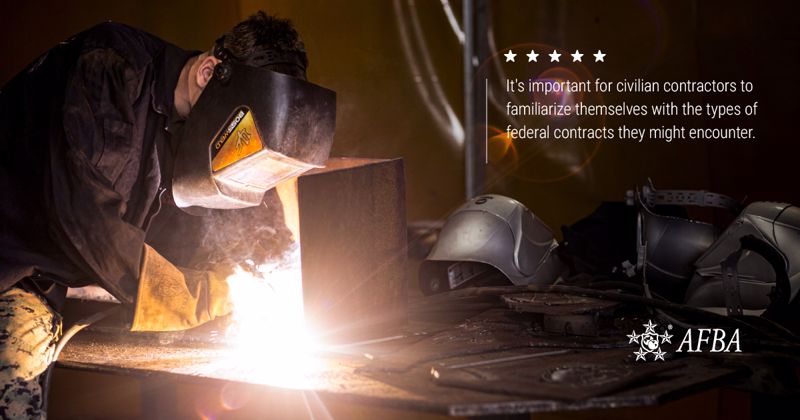
Fixed-price contracts
Fixed-price contracts are among the most common types of federal contracts. Within this category, contracts can come with a few different features.
The most basic is the firm-fixed-price (FFP) contract, wherein the price set for the supplies or services is set and paid out as a fixed, flat rate. This is useful for contractors providing specific products or services for which they can confidently determine the costs beforehand.
Similar to the FFP are fixed-price contracts with prospective price redetermination. After sticking to a firm fixed price for an introductory period, both parties will review the price and revise it as needed to account for market fluctuations and other contingencies.
Another contract type in this category is the fixed-price economic price adjustment contract. Under this arrangement, contractors may secure additional payment if market rates for the labor or materials required to complete the contract deliverables suddenly increase. This offers an advantage for companies that rely upon unstable markets for material and human resources.
Fixed-ceiling-price contracts with retroactive price redetermination are another variation. These are typically used for research and development projects. The civilian contractor and federal agency will agree upon a price cap prior to beginning the work and will adjust the compensation level — keeping it at or below that price ceiling — after the services have been rendered.
Cost-reimbursement contracts
A more common category for R & D service providers is the cost-reimbursement contract. This places less risk on the company, which may incur variable costs while providing the federal agency's required services. Under cost-reimbursement contract arrangements, the government will pay for incurred costs up to a certain amount. These are only available in situations where the contractor can't accurately project the associated costs for their services.
Variations include a range of cost-plus-fee contracts, where the contractor receives either an award, incentive or fixed fee in addition to the reimbursement.
Alternatively, cost contracts are designed primarily for nonprofit organizations that render R & D services without collecting a fee but still require their costs covered.
Other types of federal contracts
Beyond those two most common types of federal contracts, a handful of other options exist.
First, incentive contracts can be structured similarly to fixed-price or cost-reimbursement contracts but feature an incentive tied to the contractor's performance, such as the ability to provide expedited service or come in under budget.
Next, the government may issue indefinite-delivery or indefinite-quantity contracts to companies whose services are hard to quantify ahead of time. This can be useful when services are contingent upon unpredictable factors or desired quantities are not yet known by the agency.
Finally, time-and-materials contract and labor-hour contract arrangements meant that the provider will be compensated for actual wage-based labor and materials costs at a fixed rate. These are used only when the duration of the contract is unknown and are typically issued for short-term projects.
This range of federal contracts gives civilian providers and federal agencies flexibility when coming to an agreement and delivering or procuring goods and services.


